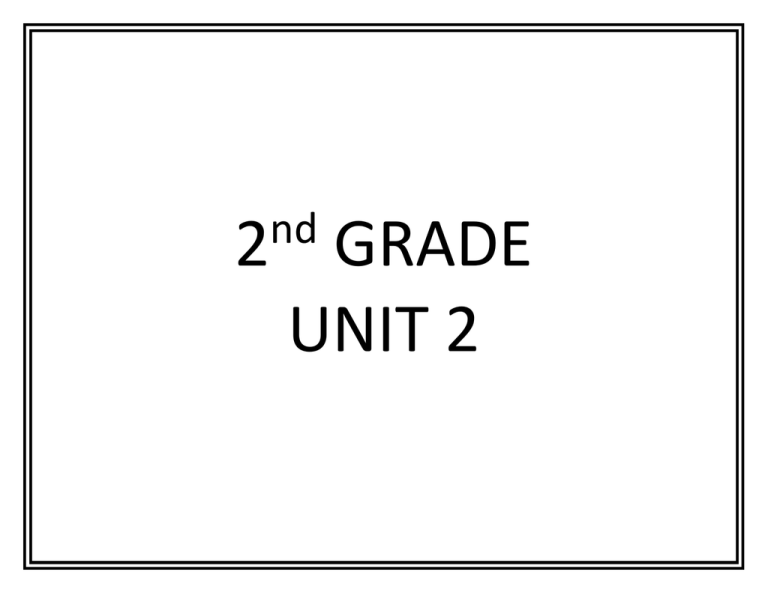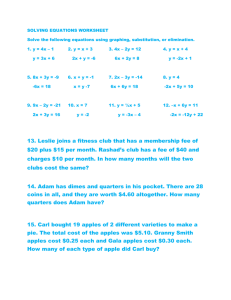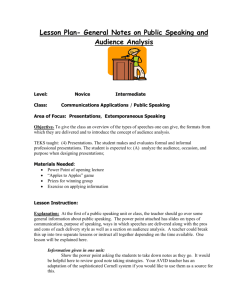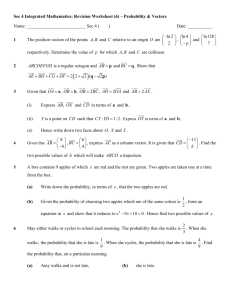2nd Grade
advertisement

nd 2 GRADE UNIT 2 2nd Grade Vocabulary Mathematics Unit 2 VOCABULARY addend word problem standard form addition odd compare base-ten blocks place value greater than > difference strategy hundreds doubles subtraction less than < equation symbol ones even unknown same as ( is equal) = fluently base-ten numeral tens making tens expanded form three-digit number number line number name (word form) two-digit number *The list of terms is not all inclusive for this unit, but is for teacher instructional use. August 2015 Unit 2 - 1 2nd Grade Curriculum Map Mathematics Unit 2 OPERATIONS AND ALGEBRAIC THINKING Represent and solve problems involving addition and subtraction. CC.2.OA.1 Use addition and subtraction within 100 to solve one- and two-step word problems involving situations of adding to, taking from, putting together, taking apart, and comparing, with unknowns in all positions, e.g., by using drawings and equations with a symbol for the unknown number to represent the problems. B. Add to: Change Unknown (2 + ? = 5) E. Take from: Change Unknown (5 – ? = 3) H. Put Together/Take apart: Addend Unknown (3 + ? = 5, 5 – 3 = ?) I. Put Together/ Take apart: Both addends unknown (5=1+4, 5=4+1) TABLE 1. Common addition and subtraction situations. Result Unknown Two bunnies sat on the grass. Three more bunnies hopped there. How many bunnies are on the grass now? Add to 2+3=? A Five apples were on the table. I ate two apples. How many apples are on the table now? Take from 5–2=? D Put Together/ Take apart Total Unknown Three red apples and two green apples are on the table. How many apples are on the table? 3+2=? G Change Unknown Two bunnies were sitting on the grass. Some more bunnies hopped there. Then there were 5 bunnies. How many bunnies hopped over to the first two? 2+?=5 B Five apples were on the table. I ate some apples. Then there were three apples. How many apples did I eat? 5-?=3 E Addend Unknown Five apples are on the table. Three are red and the rest are green. How many apples are green? 3 + ? = 5, 5 – 3 = ? H Start Unknown Some bunnies were sitting on the grass. Three more bunnies hopped there. Then there were five bunnies. How many bunnies were on the grass before? ?+3=5 C Some apples were on the table. I ate two apples. Then there were three apples. How many apples were on the table before? ?–2=3 F Both addends Unknown Grandma has five flowers. How many can she put in her red vase and how many in her blue vase? 5 = 0 + 5, 5 = 5 + 0 5 = 1 + 4, 5 = 4 + 1 5 = 2 + 3, 5 = 3 + 2 I Continued on next page August 2015 Unit 2 - 2 Compare Difference Unknown (“How many more?” version): Lucy has two apples. Julie has five apples. How many more apples does Julie have than Lucy? Bigger Unknown (Version with“ more”): Julie has three more apples than Lucy. Lucy has two apples. How many apples does Julie have? Smaller Unknown (Version with“ more”): Julie has three more apples than Lucy. Julie has five apples. How many apples does Lucy have? (“How many fewer?” version): Lucy has two apples. Julie has five apples. How many fewer apples does Lucy have than Julie? 2 + ? = 5, 5 – 2 = ? (Version with “fewer”): Lucy has 3 fewer apples than Julie. Lucy has two apples. How many apples does Julie have? 2 + 3 = ?, 3 + 2 = ? (Version with “fewer”): Lucy has 3 fewer apples than Julie. Julie has five apples. How many apples does Lucy have? 5 – 3 = ?, ? +3 = 5 J K Two Operations, Same Two-Step Problems There are 9 blue marbles and 6 red marbles in the bag. Maria put in * more marbles. How many marbles are in the bag now? 9+6+8=? M L Two Operations, Opposite There are 9 peas on the plate. Carlos ate 5 peas. Mother put 7 more peas on the plate. How many peas are on the plate now? 9–5+7= M Standards for Mathematical Practice: 2: Reason abstractly and quantitatively 3: Construct viable arguments and critique the reasoning of others 4: Model with mathematics 5: Use appropriate tools strategically 8: Look for and express regularity in repeated reasoning Explanations and Examples: Second Grade students extend their work with addition and subtraction word problems in two major ways. First, they represent and solve word problems within 100, building upon their previous work to 20. In addition, they represent and solve one and two-step word problems of all three types (Result Unknown, Change Unknown, Start Unknown). One-step word problems use one operation. Two-step word problems use two operations which may include the same operation or opposite operations. As second grade students solve one- and two-step problems they use manipulatives such as snap cubes, place value materials (groupable and pre-grouped), ten frames, etc.; create drawings of manipulatives to show their thinking; or use number lines to solve and describe their strategies. They then relate their drawings and materials to equations. By solving a variety of addition and subtraction word problems, second grade students determine the unknown in all positions (Result unknown, Change unknown, and Start unknown). Rather than a letter (“n”), boxes or pictures are used to represent the unknown number. Second Graders use a range of methods, often mastering more complex strategies such as making tens and doubles and near doubles for problems involving addition and subtraction within 20. Moving beyond counting and counting-on, second grade students apply their understanding of place value to solve problems. One-Step Example: Some students are in the cafeteria. 24 more students came in. Now there are 60 students in the cafeteria. How many were in the cafeteria to start with? Use drawings and equations to show your thinking. Continued on next page August 2015 Unit 2 - 3 Student A: I read the equation and thought about how to write it with numbers. I thought, “What and 24 makes 60?” So, my equation for the problem is □ + 24 = 60. I used a number line to solve it. I started with 24. Then I took jumps of 10 until I got close to 60. I landed on 54. Then, I took a jump of 6 to get to 60. So, 10 + 10 + 10 + 6 = 36. So, there were 36 students in the cafeteria to start with. Student B: I read the equation and thought about how to write it with numbers. I thought, “There are 60 total. I know about the 24. So, what is 60 – 24?” So, my equation for the problem is 60 – 24 = □ I used place value blocks to solve it. I started with 60 and took 2 tens away. I needed to take 4 more away. So, I broke up a ten into ten ones. Then, I took 4 away. That left me with 36. So, 36 students were in the cafeteria at the beginning. 60 – 24 = 36 Two-Step Example: There are 9 students in the cafeteria. 9 more students come in. After a few minutes, some students leave. There are now 14 students in the cafeteria. How many students left the cafeteria? Use drawings and equations to show your thinking. Student A I read the equation and thought about how to write it with numbers: 9 + 9 - □ = 14. I used a number line to solve it. I started at 9 and took a jump of 9. I landed on 18. Then, I jumped back 4 to get to 14. So, overall, I took 4 jumps. 4 students left the cafeteria. Continued on next page August 2015 Unit 2 - 4 Student B I read the equation and thought about how to write it with numbers: 9 + 9 - □ = 14. I used doubles to solve it. I thought about double 9s. 9 + 9 is 18. I knew that I only needed 14. So, I took 4 away, since 4 and 4 is eight. So, 4 students left the cafeteria. Resources: Notes: Add to: Change Unknown Problems to 100 Add to: Start Unknown Problems to 100 Take from: Change Unknown Problems to 100 Word Problems (One Step) Word Problems (Two Step) http://www.illustrativemathematics.org/standards/k8 TN Curriculum Resources About Teaching Mathematics a K-8 Resource by Marilyn Burns The Rooster’s Journey One Gorilla and More Making Books with Dots August 2015 Unit 2 - 5 Add and subtract within 20. CC.2.OA.2 Fluently add and subtract within 20 using mental strategies. By end of Grade 2, know from memory all sums of two one-digit numbers. A. Addition B. Subtraction Standards for Mathematical Practice: 2: Reason abstractly and quantitatively 7: Look for and make use of structure 8: Look for and express regularity in repeated reasoning Explanations and Examples: Building upon their work in First Grade, Second Graders use various addition and subtraction strategies in order to fluently add and subtract within 20: 1.OA.6 Mental Strategies Counting on Making ten (e.g., 8 + 6 = 8 + 2 + 4 = 10 + 4 = 14) Decomposing a number leading to a ten (e.g., 13 – 4 = 13 – 3 – 1 = 10 – 1 = 9) Using the relationship between addition and subtraction (e.g., knowing that 8 + 4 = 12, one knows 12 – 8 = 4) Creating equivalent but easier or known sums (e.g., adding 6 + 7 by creating the known equivalent 6 + 6 + 1 = 12, 12 + 1 = 13 Second Graders internalize facts and develop fluency by repeatedly using strategies that make sense to them. When students are able to demonstrate fluency they are accurate, efficient, and flexible. Students must have efficient strategies in order to know sums from memory. Continued on next page August 2015 Unit 2 - 6 Developing Fluency for Addition & Subtraction within 20 Example: 9 + 5= _____ Student A Counting On I started at 9 and then counted 5 more. I landed on 14. Student B Decomposing a Number-Leading to a Ten I know that 9 and 1 is 10, so I broke 5 into 1 and 4. 9 plus 1 is 10. Then I have to add 4 more, which is 14. Example: 13 - 9 = _____ Student A Using the Relationship between Addition and Subtraction I know that 9 plus 4 equals 13. So 13 minus 9 is 4. Resources: K-5 Math Teaching Resources Doubles Bump Student B Creating an Easier Problem Instead of 13 minus 9, I added 1 to each of the numbers to make the problem 14 minus 10. I know the answer is 4. So 13 minus 9 is also 4. Notes: Near 20 Magic Star Puzzle Magic Triangles Magic Square Nine Plus Fact Family House Doubles Plus One Doubles Minus One Continued on next page August 2015 Unit 2 - 7 Eleven More Four in a Row with Near Doubles ver. 1 Four in a Row with Near Doubles ver. 2 Number Relationship Mat TN Curriculum Center About Teaching Mathematics a K-8 Resource by Marilyn Burns Pinch a 10 August 2015 Unit 2 - 8 Work with equal groups of objects to gain foundations for multiplication. CC.2.OA.3 Determine whether a group of objects (up to 20) has an odd or even number of members, e.g., by pairing objects or counting them by 2s; write an equation to express an even number as a sum of two equal addends. A. Even and odd B. Write an equation Standards for Mathematical Practice: 2: Reason abstractly and quantitatively 3: Construct viable arguments and critique the reasoning of others 7: Look for and make use of structure 8: Look for and express regularity in repeated reasoning Explanations and Examples: Second graders apply their work with doubles to the concept of odd and even numbers. Students should have ample experiences exploring the concept that if a number can be decomposed (broken apart) into two equal addends or doubles addition facts (e.g., 10 = 5 +5), then that number (10 in this case) is an even number. Students should explore this concept with concrete objects (e.g., counters, cubes, etc.) before moving towards pictorial representations such as circles or arrays. Example: Is 8 an even number? Justify your thinking. Student A I grabbed 8 counters. I paired counters up into groups of 2. Since I didn’t have any counters left over; I know that 8 is an even number. Student C I drew 8 boxes in a rectangle that had two columns. Since every box on the left matches a box on the right, I know that 8 is even. Student B I grabbed 8 counters. I put them into 2 equal groups. There were 4 counters in each group, so 8 is an even number. Student D I drew 8 circles. I matched one on the left with one on the right. Since they all match up I know that 8 is an even number Student E I know that 4 plus 4 equals 8. So 8 is an even number. Continued on next page August 2015 Unit 2 - 9 The focus of this standard is placed on the conceptual understanding of even and odd numbers. An even number is an amount that can be made of two equal parts with no leftovers. An odd number is one that is not even or cannot be made of two equal parts. The number endings of 0, 2, 4, 6, and 8 are only an interesting and useful pattern or observation and should not be used as the definition of an even number. (Van de Walle & Lovin, 2006, p. 292) Resources: Even Odd Pattern Block Grab Notes: Even Odd Grab Even Odd Song Odd and Even Read-Alouds TN Curriculum Center http://www.illustrativemathematics.org/standards/k8 http://www.illustrativemathematics.org/illustrations/620 GA Common Core Unit 6 What’s In the Bag? Cookie Monster Add It Up Math Work Stations by Debbie Diller Odd and Even About Teaching Mathematics a K-8 Resource by Marilyn Burns Spill and Compare August 2015 Unit 2 - 10 CC.2.NBT.3 Read and write numbers to 1000 using base-ten numerals, number names, and expanded form. Standards for Mathematical Practice: 2: Reason abstractly and quantitatively 6: Attend to precision 7: Look for and make use of structure 8: Look for and express regularity in repeated reasoning Explanations and Examples: Second graders read, write and represent a number of objects with a written numeral (number form or standard form). These representations can include snap cubes, place value (base 10) blocks, pictorial representations or other concrete materials. Please be cognizant that when reading and writing whole numbers, the word “and” should not be used (e.g., 235 is stated and written as “two hundred thirty-five). Expanded form (125 can be written as 100 + 20 + 5) is a valuable skill when students use place value strategies to add and subtract large numbers in 2.NBT.7. Resources: Brain Pop Jr. Videos: Place Value Make 6 Numbers Notes: Number Word Concentration Representing Numbers in Four Ways Number Writing Barrier Game Roll 3 Digits TN Curriculum Resource Number-I Spy 10 Things to do with 1,000 Math Work Stations by Debbie Diller What’s My Number? August 2015 Unit 2 - 11 CC.2.NBT.4 Compare two and three-digit numbers based on meanings of the hundreds, tens, ones digits, using >, =, and < symbols to record the results of comparisons. Standards for Mathematical Practice: 2: Reason abstractly and quantitatively 6: Attend to precision 7: Look for and make use of structure 8: Look for and express regularity in repeated reasoning Explanations and Examples: Second Grade students build on the work of 2.NBT.1 and 2.NBT.3 by examining the amount of hundreds, tens and ones in each number. When comparing numbers, students draw on the understanding that 1 hundred (the smallest three-digit number) is actually greater than any amount of tens and ones represented by a two-digit number. When students truly understand this concept, it makes sense that one would compare three-digit numbers by looking at the hundreds place first. Students should have ample experiences communicating their comparisons in words before using symbols. Students were introduced to the symbols greater than (>), less than (<) and equal to (=) in First Grade and continue to use them in Second Grade with numbers within 1,000. Example: Compare these two numbers. 452 455 Student A Place Value 452 has 4 hundreds 5 tens and 2 ones. 455 has 4 hundreds 5 tens and 5 ones. They have the same number of hundreds and the same number of tens, but 455 has 5 ones and 452 only has 2 ones. 452 is less than 455. 452 < 455 Student B Counting 452 is less than 455. I know this because when I count up I say 452 before I say 455. 452 < 455 452 is less than 455. While students may have the skills to order more than 2 numbers, this Standard focuses on comparing two numbers and using reasoning about place value to support the use of the various symbols. Resources: Notes: Brain Pop Jr. Video (comparing numbers) Comparing 3 Digit Numbers Place Value Challenge (3 Digits) About Teaching Mathematics a K-8 Resource by Marilyn Burns Spill and Compare Math Work Stations by Debbie Diller Compare numbers Compare Numbers from 100-999 August 2015 Unit 2 - 12




